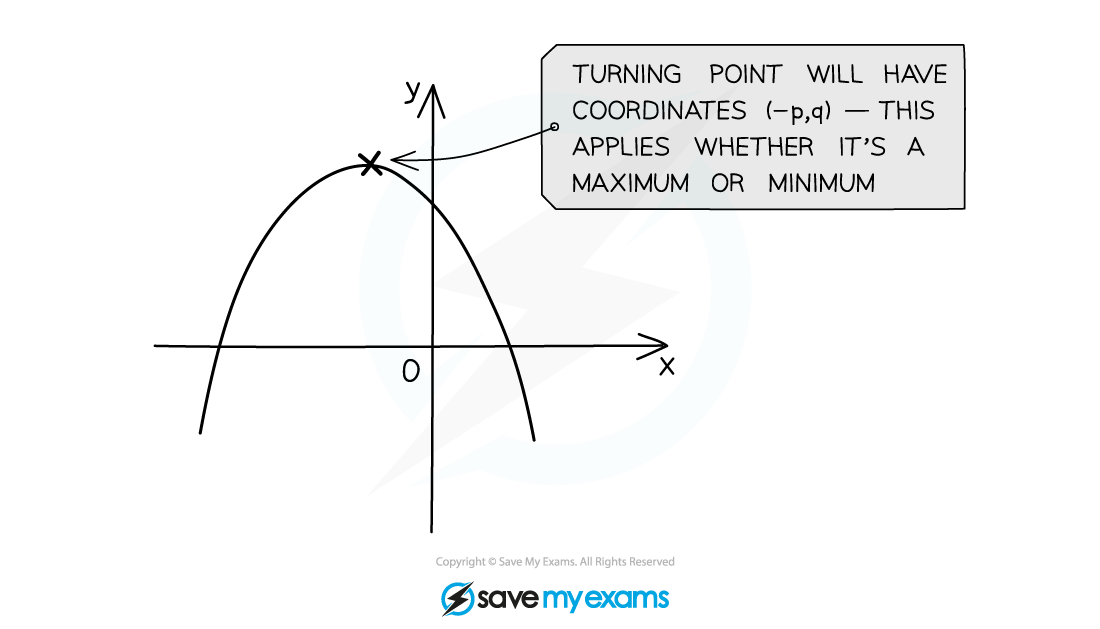Did this video help you?
Completing the Square: Revision Note
Completing the Square
How can I rewrite the first two terms of a quadratic expression as the difference of two squares?
- Look at the quadratic expression x2 + bx + c
- The first two terms can be written as the difference of two squares using the following rule
is the same as
where
is half of
- Check this is true by expanding the right-hand side
- Is
the same as
?
- Yes: (x + 1)(x + 1) - 12 = x2 + 2x + 1 - 1 = x2 + 2x
- Is
- This works for negative values of b too
-
can be written as
which is
- A negative b does not change the sign at the end
-
How do I complete the square?
- Completing the square is a way to rewrite a quadratic expression in a form containing a squared-bracket
- To complete the square on x2 + 10x + 9
- Use the rule above to replace the first two terms, x2 + 10x, with (x + 5)2 - 52
- add 9: (x + 5)2 - 52 + 9
- simplify the numbers: (x + 5)2 - 25 + 9
- answer: (x + 5)2 - 16
How do I complete the square when there is a coefficient in front of the x2 term?
- You first need to take
out as a factor of the x2 and x terms only
- Use square-shaped brackets here to avoid confusion with curly brackets later
- Then complete the square on the bit inside the square-brackets:
- This gives
- where p is half of
- where p is half of
- This gives
- Finally multiply this expression by the a outside the square-brackets and add the c
- This looks far more complicated than it is in practice!
- Usually you are asked to give your final answer in the form
- Usually you are asked to give your final answer in the form
- For quadratics like
, do the above with a = -1

How do I find the turning point by completing the square?
- Completing the square helps us find the turning point on a quadratic graph
- If
then the turning point is at
- Notice the negative sign in the x-coordinate
- This links to transformations of graphs (translating
by p to the left and q up)
- If
then the turning point is still at
- It's at a minimum point if a > 0
- It's at a maximum point if a < 0
- If
- It can also help you create the equation of a quadratic when given the turning point

- It can also be used to prove and/or show results using the fact that any "squared term", i.e. the bracket (x ± p)2, will always be greater than or equal to 0
- You cannot square a number and get a negative value

Examiner Tip
- To know if you have completed the square correctly, expand your answer to check.
Worked example
Find half of +6 (call this p)
Factorise -3 out of the first two terms only
Use square-shaped brackets
Complete the square on the x2 - 4x inside the brackets (write in the form (x + p)2 - p2 where p is half of -4)
Simplify the numbers inside the brackets
(-2)2 is 4
Multiply -3 by all the terms inside the square-shaped brackets
Simplify the numbers
This is now in the form a(x + p)2 + q where a = -3, p = -2 and q = 36
Solving by Completing the Square
How do I solve a quadratic equation by completing the square?
- To solve x2 + bx + c = 0
- replace the first two terms, x2 + bx, with (x + p)2 - p2 where p is half of b
- this is called completing the square
- x2 + bx + c = 0 becomes
- (x + p)2 - p2 + c = 0 where p is half of b
- x2 + bx + c = 0 becomes
- rearrange this equation to make x the subject (using ±√)
- For example, solve x2 + 10x + 9 = 0 by completing the square
- x2 + 10x becomes (x + 5)2 - 52
- so x2 + 10x + 9 = 0 becomes (x + 5)2 - 52 + 9 = 0
- make x the subject (using ±√)
- (x + 5)2 - 25 + 9 = 0
- (x + 5)2 = 16
- x + 5 = ±√16
- x = ±4 - 5
- x = -1 or x = -9
- If the equation is ax2 + bx + c = 0 with a number in front of x2, then divide both sides by a first, before completing the square
How does completing the square link to the quadratic formula?
- The quadratic formula actually comes from completing the square to solve ax2 + bx + c = 0
- a, b and c are left as letters, to be as general as possible
- You can see hints of this when you solve quadratics
- For example, solving x2 + 10x + 9 = 0
- by completing the square, (x + 5)2 = 16 so x = ± 4 - 5 (from above)
- by the quadratic formula,
= ± 4 - 5 (the same structure)
- For example, solving x2 + 10x + 9 = 0
Examiner Tip
- When making x the subject to find the solutions at the end, don't expand the squared brackets back out again!
- Remember to use ±√ to get two solutions
Worked example
Solve by completing the square
Divide both sides by 2 to make the quadratic start with x2
Halve the middle number, -4, to get -2
Replace the first two terms, x2 - 4x, with (x - 2)2 - (-2)2
Simplify the numbers
Add 16 to both sides
Square root both sides
Include the ± sign to get two solutions
Add 2 to both sides
Work out each solution separately
x = 6 or x = -2

You've read 0 of your 5 free revision notes this week
Sign up now. It’s free!
Did this page help you?
